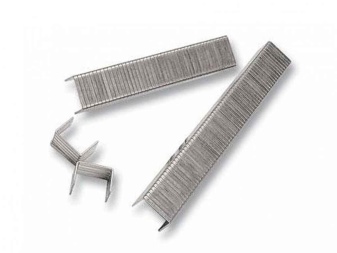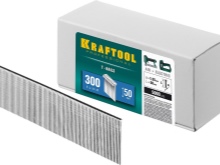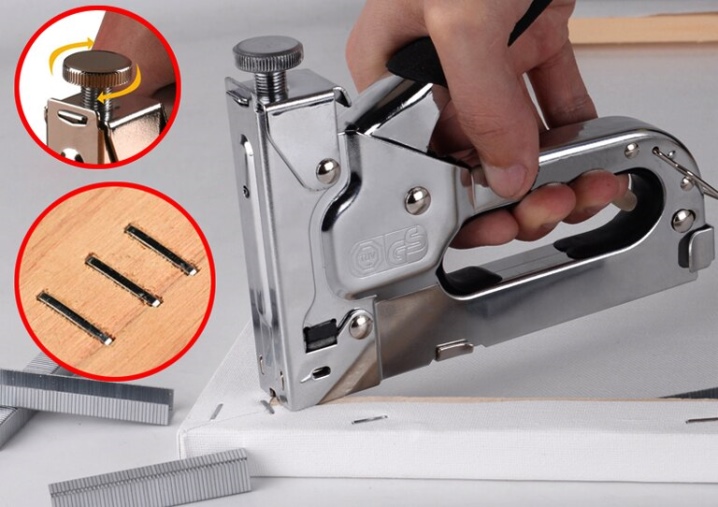Features of staples for furniture staplers

In everyday life, a furniture stapler is widely used. It allows you to make repairs in the apartment, fix furniture and many other little things. The stapler uses in its work special plates - staples. In order for the repair or repair to be effective, you should choose them correctly, and for this you need to understand the features and variety of these consumables.

Species overview
There is a huge assortment of staples on the modern market - in the most ordinary hardware store you can find at least 5 varieties of goods. When choosing them, it is important to take into account the features of the stapler and the type of material that will be stapled. Basically, staples for a furniture stapler differ in several characteristics.
-
Depth. This parameter varies from 4 to 14 mm, the smallest are designed for bonding thin materials, while the larger ones are used for larger parts.
-
Type of. Types 53 and 140 are commonly used, but you can also find 300, 500 and a few others.
-
The size. The parameters of height, width and thickness are different.
-
The form. Can be U-, U- or T-shaped.
-
Manufacturing material. Distinguish between rusting and stainless, hard and soft, cheap and expensive.
-
With and without sharpened legs. Another important parameter that affects the quality and speed of fastening parts.


Staple manufacturers try to attract buyers and produce various types, combining their characteristics in a random order and at the request of the client. However, even if one company is very popular, and you have always purchased their staples for working with wood, this does not mean that you also need to go to them for a product for metal elements.
It is important to look not at the manufacturer or the name, but at the specific features.

To find the right option without any problems, you need to pay attention to the marking of the staples. They are marked by type and size:
-
53, 53F, 50 are U-shaped;
-
J - T-shaped;
-
S, L - in the form of an arc, U-shaped.
The size and width are indicated after the type. For example:
-
53F 11.3x1.25 is a U-shaped bracket with a width of 11.3 mm and a thickness of 1.25 mm;
-
J 1.8x1.7 - T-shaped bracket, which is 1.8 mm wide and 1.7 mm thick.

By form
Staples vary in shape. The choice of form depends on the parameters of the stapler and the purpose of use.
-
P. This form is considered universal and is most often used in practice. It is suitable for most of the tasks required of a stapler.
-
U. This shape has an arched appearance. It is also quite often used in practice. It is mainly used for holding wires together. In this case, the arc shape will prevent damage to the wire.
-
T. These staples are shaped like nails. In practice, they are rarely used, because the price for them is quite high, the strength of the fasteners is weak. Used for fastening plywood, thin wood, chipboard.



To size
Size is an important consideration when choosing staples. It includes characteristics such as type, width, thickness, height, depth. Let's start with types.
-
Type 53 - for lightweight woven and sheet fabrics. They have thin legs that hardly damage the product.

- Type 13 - also for lightweight materials. This type is used when high loads are not required from the material to be bonded.

- Type 53F is a subspecies of type 53, but slightly thicker. Able to connect several thin layers.

- Type 140 - does not spoil the appearance. Like types 53, 53F, it is used for bonding thin materials. Has a smaller width and the same or greater thickness.

- Type 300 - suitable for joining materials from plastic, wood, fiberboard sheets. They are shaped like nails.

- Type 500 - also used for fastening wood or plastic workpieces. They are distinguished by their invisibility due to the shape of the studs.

- Type 28 - for cables. They have an arched shape, so they do not spoil the wire.

Distinguish the sizes of staples in width, height, thickness:
-
width - 1.26 mm, 1.45 mm, 4.5 mm, 6 mm, 10 mm, 11.3 mm, 11.4 mm, 12.3 mm, 12.9 mm;
-
thickness - 0.7 mm, 0.72 mm, 0.75 mm, 1 mm, 1.25 mm, 1.8 mm;
-
height - 4 mm, 6 mm, 8 mm, 10 mm, 11 mm, 12 mm, 14 mm, 19 mm, 23 mm, 30 mm.
The size of the staple also determines its depth. This indicator varies from 4 to 14 mm. The main thing here is to know to what maximum depth your stapler can drive.
As a rule, hand staplers have the highest rate.

Manufacturing materials
The staples are made from different materials. The physical properties of the product will depend on this. Manufacturing materials are divided into corrosive (rusting) and non-corrosive (stainless).
The first type is steel. It can be hardened and without annealing. The first will cost more, but it is also stronger. Both options rust, that is, they are prone to corrosion. The advantage of steel is its strength. Staples from such a material are used to fasten rigid frames that are subject to constant stress.

From stainless materials of manufacture, aluminum and copper can be distinguished. Copper is a rather expensive material and also very soft. Aluminum, on the other hand, stands out for its cheapness, but low rigidity. Copper is suitable for rooms with high humidity. Aluminum is used with soft materials such as pine. With a harder and more rigid frame, the aluminum and copper brackets will fold.

And also a zinc-coated stainless steel is used, but you can find staples without it. This type is the most popular due to its low price and high rigidity of the staples.
Which staples are best for you?
Among the many different types of staples for a furniture stapler, one cannot single out the best and most effective ones. For a quality repair, you need to select the staples that are suitable for your specific stapler and situation.
The first step is to find out which staples your stapler can use. You can find out in the instrument's passport. Different staplers can use brackets with different sizes, shapes.

And also it is worth deciding on the shape of the brackets. For simple tasks, it is recommended to take types P, for fastening round or cylinder-shaped parts, for example, wires or cables, it is better to take U-shape brackets. It is recommended to take T-shaped ones only in those cases when you need to pierce strong parts.

The material of the staples also plays an important role. Aluminum braces are better for simple purposes, they are the cheapest and most practical for their price. Copper is best used in rooms with high humidity. Due to its color, such material can also be used in places where the staples are too visible. They will add more aestheticism to the product. Steel or stainless steel is used to fasten rigid parts. They will be the most expensive and reliable.
When choosing steel staples, hardened products are the best option. They can be more expensive, but they will be much stronger than their non-hardened counterparts.

It is also worth paying attention to the type of legs: they can be sharpened and not sharpened. It is recommended to take with sharpened legs. For a manual stapler, they will make it easier to drive in staples, for an electric stapler, they will extend its life. Blunt ends will not play a big role when working with thin materials, but they will be strongly felt when installing harder parts.
The price of staples varies greatly. Here you need to understand that the higher the price, the lower the likelihood of marriage. This should be taken into account: when buying cheap brackets, you need to take more of them, when buying expensive ones, you can take a very small stock.
It is important to select the correct staple depth. For simple tasks, deep shackles are not required. However, if necessary, it is worth knowing how long your device can hammer. The cheapest staplers can hammer no more than 8 mm, the more expensive and advanced ones - up to 14 mm. It must be understood that the greater the depth, the greater the load the staples can withstand.

How to insert and replace?
In order to replace the staples in a furniture stapler, you need to follow a series of steps.
-
Secure the stapler with a fuse. This will protect against accidents.
-
After that, you need to remove the store, or open the stapler cover.
-
Then you should get a rod with a pushing spring or, in other words, a pushing mechanism.
-
The next step is to turn the staple rail with the tip against the handle and insert it into the groove.
-
When everything is ready, you will need to restore the bracket set to the store, close and fix the lid.
-
After all these steps, you can remove the fuse and get to work.

Staples for furniture staplers differ in many characteristics and have different parameters. When choosing, it is worth considering the purpose of buying staples and the possibilities of a stapler, as well as taking into account all the features indicated by the manufacturer on the packaging. The company from which you plan to purchase staples is not the last selection criterion, it is best to study the reviews, and then draw conclusions. After purchase, you must read the instructions for replacing staples and, following it, refuel. Correctly selected and installed brackets will make the job easier, so it is worth approaching the matter responsibly.















The comment was sent successfully.